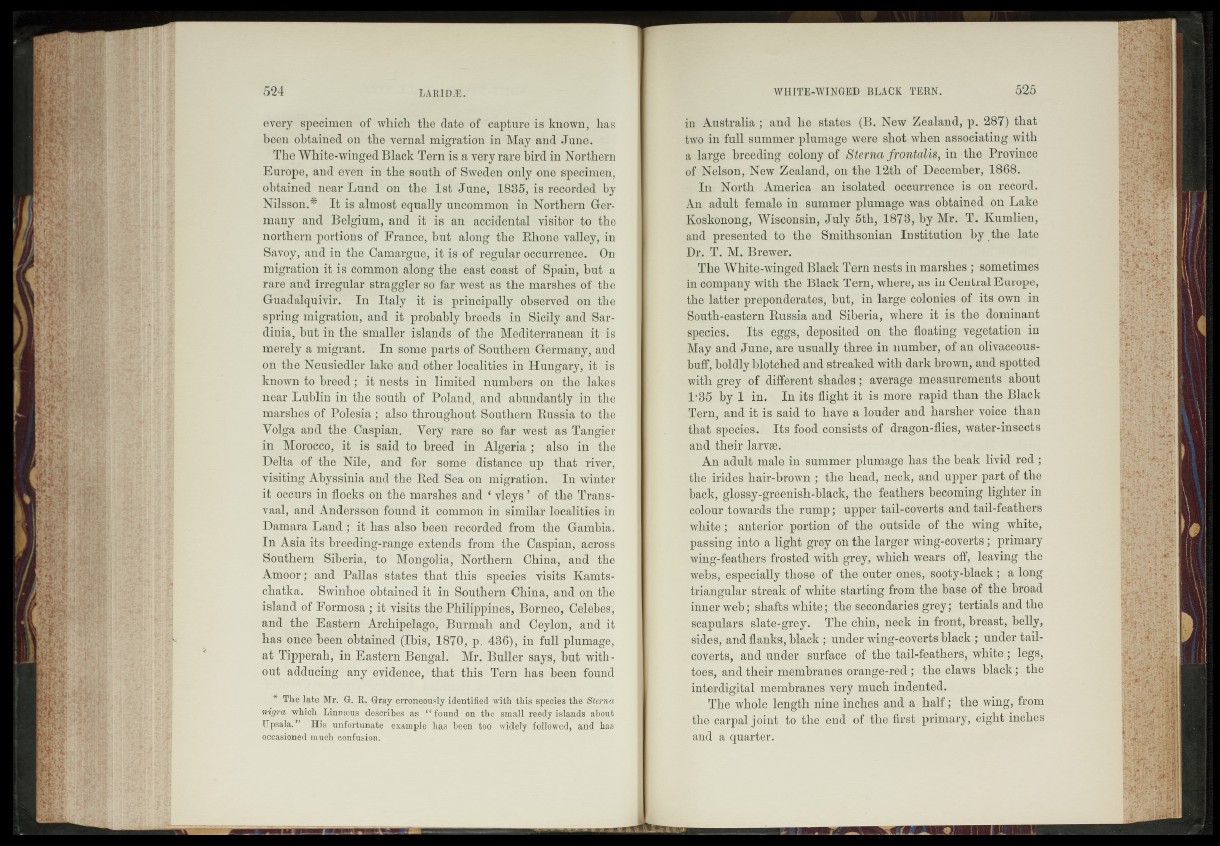
every- specimen of which the date of capture is known, has
been obtained on the Vernal migration in' May and June. •
The White-winged Black Tern is a very rare bird in Northern
Europe, and even m the aouth of Sweden only one'specimen,
obtained near Lund on the 1st June, 1885, is recorded by
Nilsson.* It- is almost equally uncommon 'in Northern Germany
and Belgium, and it is an accidental visitor taBhe
northern portions of France, but along the-Rhone valley,- in
Savoy, and in the Camargue, it is of regular occurrence. On
migration it is common along the east^oaBt of -Spain) but|a
rare and irregular straggler so far^wést as the marshes of the
Guadalquivir'. In Italy it- is principally observed oh "the
spring migration, and it probably-breeds h^¥ie%»and ^Sardinia,
but in the smaller islandsE Oh the Mediterranean it is
merely a migrant. In some^parts- of Southern Germany, and
on-the Nbusiédler-lake and- other localities in Hungary* it K
known to breed; it bests'in limited numbers'''on the'lakes
near Lublin in the south of Poland’, and ahundafitly^i^llhe
marshes of Polesia j-also'-thi%u^höh-t Southern Russia to'/the
Volga and the Caspian. AVery- rare so far wést' - as'*:Tangier
in Morocco, it- is said to brééd in* Algeria ; ;~aïg%3-ipvthe
Delta oi the- '^M^ and for 'some “1 distance‘up that riy-ef,
visiting Abyssinia and-the' Red^S'ea on migratibnv/ Inhaftnter
it-occhrs ■ in- flocks -on tnè marsh'es and ‘ vleyS ^bfllthe Transvaal,
and ‘Ahflerssón found if--common in similar localities-in
Damara Land; it has also'beenm’ecordCd from the Gambia.
In Asia its*ll^ejdihg-range extends from'wq^Caspian^^f'oss
Southern Siberia, to M’ohgohaJ Northern ' China,'an dKthe
Amoor-; and Pallas stateFthat - this speé'^s^visits Kamfs-
chatka. Swinhoe obtaihMgt in Southern China,"and%'f'tlËe
island of-Formosa; it visitSjthe Philip^Hies/ Borneo>4gMe‘bes,
and the Eastern Archipelago,^BurrUah and- Ceylon, and it
has ^ o e bëenrohtafhed' (Ibis/1870, p. 486)^in ftilhplumage,
at Tipperahj' in Eas1;ern''Bengal. Mr. Buller sayS, but*without
adducing; any’-evidence, that a^is^TeEft* has been found
U Mr. jjpkgpL Gray- erroneously i^e^t'ified with this., species the Sterna
nigra .^hieh Linpaeug dai^abeg, as hfo.und bn,,the small r§.edy islands ahojit
Upsala.” TBCis ■unfortunate’’ example 'ba-i neraftotf widely* follow on, and has
occasioned much „confusion.
in Australia ;‘and-he states; (B..-New' Zealand, p. 287) that
two in :full summer plumage were phot when associating-with
a/-large breeding colony of Sterfipirffiontalip, in the Province
of- Nelson, New Zealand, on the-l^th of-December, 1868.
Tn North America an isolated occurrence is on record.
An adult female in summer plumage was obtained pn Lake
goskonong, Wisconsin, July 5th, 1873, by Mr. T. Kumlien,
and .presented: to the Smithsonian Institution by the late
Dr. T. MhBrewer.
The Wbite-winged Black Tern nestsdn marshes ;-sqmetimes
in Company with the Black Tern, where, as in Central Europe,
d|ie latter preponderates, hut,? in large colonies-of its,own in
South-eastern Russia and Siberia, wb.-er.a-it is'--the dominant
,i|pgcies. Its . eggs, deposited-on. the floating vegetatiqp^in
May and June, are usually three in number, efan oJ-Lyaaeous-
buff, boldly blotched, and .streaked with dark brown, and spotted
with grey of - different- shades; average' measurements' about
1;35. by l dm In its flight :itfdss-mCre rapid than the Black
SPj]p.rnJ and it is- said tq -ha-vq arjoudey and -harsher voice, than
tbat ppecios;.-i Its food .consists, of dragon-flies, water-insects
and their larvse.
■ An adult-male in-summer plumage has ;the beak livid red ;
tHe ?irideS' hair-brown ; the head) nee-k,, andmppei. part ,©f djhe
back, gl-ossy-g^enisbrblack, the feathers? becoming -lighter in
rco-louf -toi®ar4s the-rump; upper tail-coverts an $..-tail-feathers
anterior. porti@/i Ojf -.the outside of the ,wing; .white,
passingdnto-a light .grey on .the larger wing-coverts; primary
W.ing-feathers frosted with-grey, which wears off, leaving dfhe
^.e})&,„especiallydfel^#f the outer, onegy goofy-black; adpng
triangular streak of white starting from the^hase-of-the--broad
inner wejg ;dshafts--whit%; .the secondaries grey;' tertials and the
rscapulars slatesfrqyr The chin, neck in front,-breast, belly,
IsidqS,-and flanks, black; under wing-coverts black ; under tail-
3^0V©rtS, and, undeiy surface of bheftail-feathers, ‘white’;- -legs,
lifbbs,, and their .membranes Qrangjfeped-; the claws /black; -the
||interdigital membranes very much indented.
pp.-Fbo.-^p^ ^ .-length nine inches and a half; the wing, from
Splhe carpal joint to /the end’kjf ithe first .primary, eight, inches
I and a quarter.